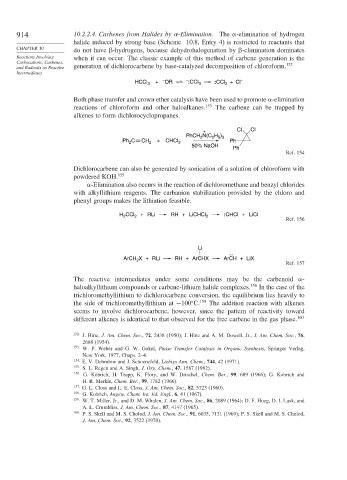Page 938 - Advanced Organic Chemistry Part B - Reactions & Synthesis
P. 938
914 10.2.2.4. Carbenes from Halides by -Elimination. The -elimination of hydrogen
halide induced by strong base (Scheme 10.8, Entry 4) is restricted to reactants that
CHAPTER 10 do not have -hydrogens, because dehydrohalogenation by -elimination dominates
Reactions Involving when it can occur. The classic example of this method of carbene generation is the
Carbocations, Carbenes, 152
and Radicals as Reactive generation of dichlorocarbene by base-catalyzed decomposition of chloroform.
Intermediates
–
HCCl + OR – :CCl 3 :CCl +Cl –
2
3
Both phase transfer and crown ether catalysis have been used to promote -elimination
reactions of chloroform and other haloalkanes. 153 The carbene can be trapped by
alkenes to form dichlorocyclopropanes.
+ Cl Cl
PhCH N(C H )
2
2 5 3
Ph C CH 2 + CHCl 3 Ph
2
50% NaOH
Ph
Ref. 154
Dichlorocarbene can also be generated by sonication of a solution of chloroform with
powdered KOH. 155
-Elimination also occurs in the reaction of dichloromethane and benzyl chlorides
with alkyllithium reagents. The carbanion stabilization provided by the chloro and
phenyl groups makes the lithiation feasible.
H CCl 2 + RLi RH + LiCHCl 2 :CHCl + LiCl
2
Ref. 156
Li
:
ArCH X + RLi RH + ArCHX ArCH + LiX
2
Ref. 157
The reactive intermediates under some conditions may be the carbenoid -
haloalkyllithium compounds or carbene-lithium halide complexes. 158 In the case of the
trichloromethyllithium to dichlorocarbene conversion, the equilibrium lies heavily to
the side of trichloromethyllithium at −100 C. 159 The addition reaction with alkenes
seems to involve dichlorocarbene, however, since the pattern of reactivity toward
different alkenes is identical to that observed for the free carbene in the gas phase. 160
152 J. Hine, J. Am. Chem. Soc., 72, 2438 (1950); J. Hine and A. M. Dowell, Jr., J. Am. Chem. Soc., 76,
2688 (1954).
153
W. P. Weber and G. W. Gokel, Phase Transfer Catalysis in Organic Synthesis, Springer Verlag,
New York, 1977, Chaps. 2–4.
154
E. V. Dehmlow and J. Schoenefeld, Liebigs Ann. Chem., 744, 42 (1971).
155 S. L. Regen and A. Singh, J. Org. Chem., 47, 1587 (1982).
156 G. Köbrich, H. Trapp, K. Flory, and W. Drischel, Chem. Ber., 99, 689 (1966); G. Kobrich and
H. R. Merkle, Chem. Ber., 99, 1782 (1966).
157
G. L. Closs and L. E. Closs, J. Am. Chem. Soc., 82, 5723 (1960).
158 G. Kobrich, Angew. Chem. Int. Ed. Engl., 6, 41 (1967).
159 W. T. Miller, Jr., and D. M. Whalen, J. Am. Chem. Soc., 86, 2089 (1964); D. F. Hoeg, D. I. Lusk, and
A. L. Crumbliss, J. Am. Chem. Soc., 87, 4147 (1965).
160
P. S. Skell and M. S. Cholod, J. Am. Chem. Soc., 91, 6035, 7131 (1969); P. S. Skell and M. S. Cholod,
J. Am. Chem. Soc., 92, 3522 (1970).

